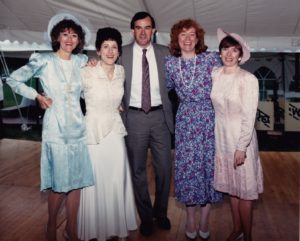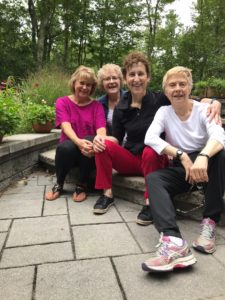How many of us have friendships that span decades and still remain intact? From my childhood, I have only one such remaining–the eleven year old girl that I called my best friend during grammar school. While there was no such thing as a BFF at the time, the acronym captures our relationship most precisely.
So, too, with my college roommate group, which had never been all together in one place since our graduation from Harvard in 1975, with the exception of a single day at one of our weddings. Over the years, we did remain in intermittent contact one on one, and almost always by phone, as we lived coasts apart: New York City, San Francisco, Seattle and Connecticut. These conversations were marked by an instantaneous connection, one belying the number of years that had passed since we’d last seen one another–the sort others often speak of when referring to re-establishing an old friendship.
But this past August, forty-three years since our parting in 1975, we reassembled at the home of one of our foursome. At last ready to remember, reminisce, and relive those unparalleled undergrad years, we intended our three-day reunion to be a snapshot: our lives back then, our lives today. We were ready for a “girls’ weekend,” even though four decades ago we would have bristled at the word “girls” and insisted on being called “women.”
We shared a history entrenched in the liberal leftovers of the ’60s. The Harvard dorms in which we met became co-ed the year before we matriculated as freshman; diminutive Radcliffe vanished into the maw of the larger university. Women and men shared the same dormitory floors and bathrooms, whether we liked it or hated it; we studied elbow-to-elbow with the “Harvard boys,” under the tutelage of Harvard professors; we earned identical Harvard degrees; we no longer belonged to Radcliffe. It wasn’t a shock when, as seniors, a fifth roommate was added to our quartet–one of the opposite sex.

At one of our weddings,
with our fifth roommate
Sophomore year, fortune brought together the three other women I would come to call life-long friends, when we were all reassigned to Mather House. The dorm was two years old, and had been built around “suites,” so that eight single rooms were linked by a common co-ed bathroom, where we shared sinks, showers and–worst of all–toilets.
Mather housed roughly four hundred men, and there were only a few of us women that first year. Perhaps thirty or so, if I remember correctly. Initially, walking into the dining room was awkward, as we were assessed by our male counterparts and generally found wanting–having cast aside mascara and miniskirts for jeans and a more natural look. And to make it all worse, we were just as brainy as those watching us over their plates of turkey tetrazzini–and thus we became threatening as well.
The Harvard “boys” usually sought out Wellesley or Pine Manor “girls”–ones who still dressed for a date and did not press to pay their share of the dinner tab. One frigid New England evening, the local weatherman summed up the nasty stereotype about us with a joke: “A Cliffie must be holding onto the thermometer bulb tonight.”
Refusing to allow such prejudice to deter us, by mid-term we had made close friends with the same young men who had once been so judgmental. However, we did earn ourselves the nickname, “The Firing Squad,” apparently because we did not welcome women from other colleges when our male friends escorted them downstairs for Sunday morning breakfast.
Over the next three years, the four of us grew into womanhood together. Side-by-side in the cramped quarters of our dorm, we tackled subjects like politics, chemistry, poetry, and art history. We fought our way to achieve a prized cum laude on our degrees. We developed our ideals of what a woman “should be,” championing Katherine Hepburn as she squared off against Spencer Tracy, or even Billie Jean King as she won her infamous tennis match against Bobby Riggs. We counseled each other through crises in love, quizzed each other for exams, ordered pepperoni pizza at midnight to quell “the munchies,” and played squash. Through it all, we remained close, grateful to have one another during these years that were both joyous and difficult.
Over time, neither the temporal nor the longitudinal distances that developed between us mattered one whit, because our relationship as a group was grounded in that initial bond: when one of us hurt, the rest of us hurt; when one celebrated, so did we all. We were linked, anchors for one another at a time of often-turbulent seas. Without a doubt, friendships such as these die hard, however much time passes.

A permanent quartet
They say you get more talkative as you get older, so it wasn’t any big surprise that we had no difficulty amusing ourselves for our seventy-two hour marathon covering forty-three years. Topics were varied–sometimes mundane, sometimes lofty, but always interesting: dismay over the aging of both body and memory; pleasure on discovering increased wisdom; which books we read for junk and which for quality; favorite movies and TV series; Me Too; the inevitable Trump; democratic socialism; wine vs. bourbon; restaurants and cooking; the rollercoasters of our careers; the loss of all eight of our parents; our complex relationships with our husbands and our children, (the latter of which includes cats and dogs). Love, life, death–and everything in between.
As our time together came to an end, we vowed to reunite next year–rather than waiting another decade or two. We’ve already picked a weekend in August of 2019, at my home in Maryland. Recently, I encountered a line by Seneca that feels just right:
“One of the most beautiful qualities of true friendship is to understand and to be understood.”
I know all four of us would agree.
Yours,
Linda
Have a comment or feedback? Talk to Linda!

